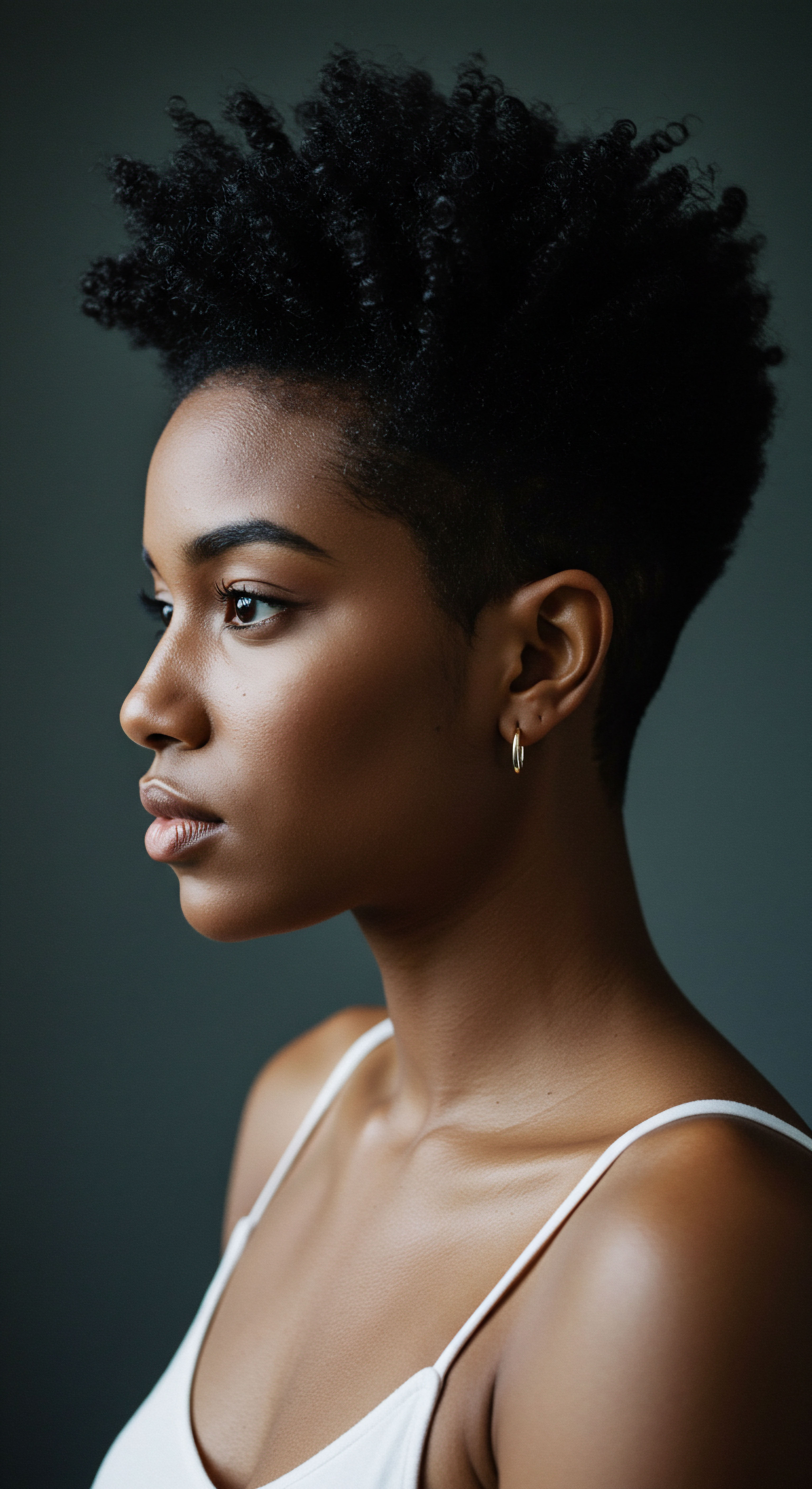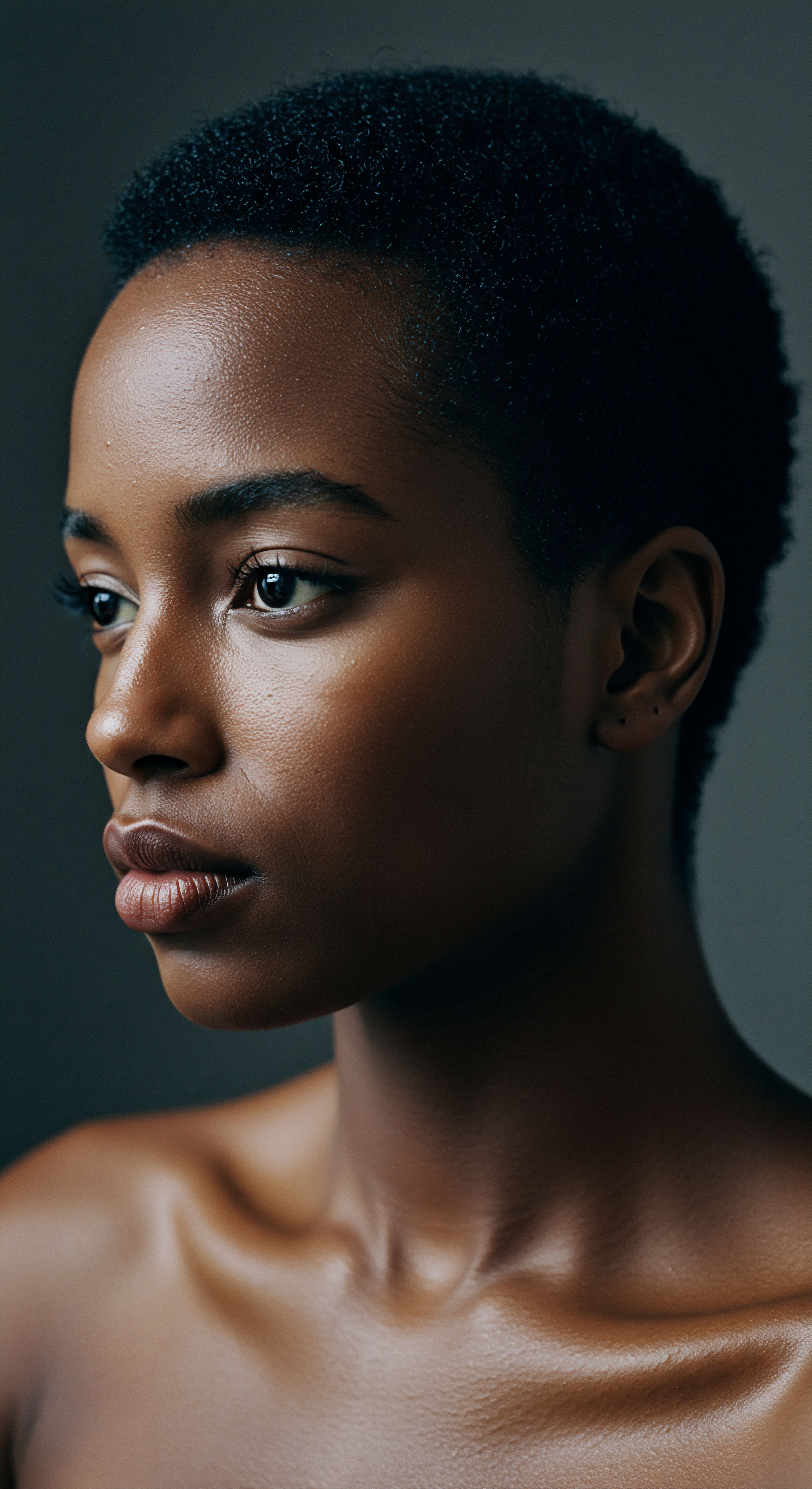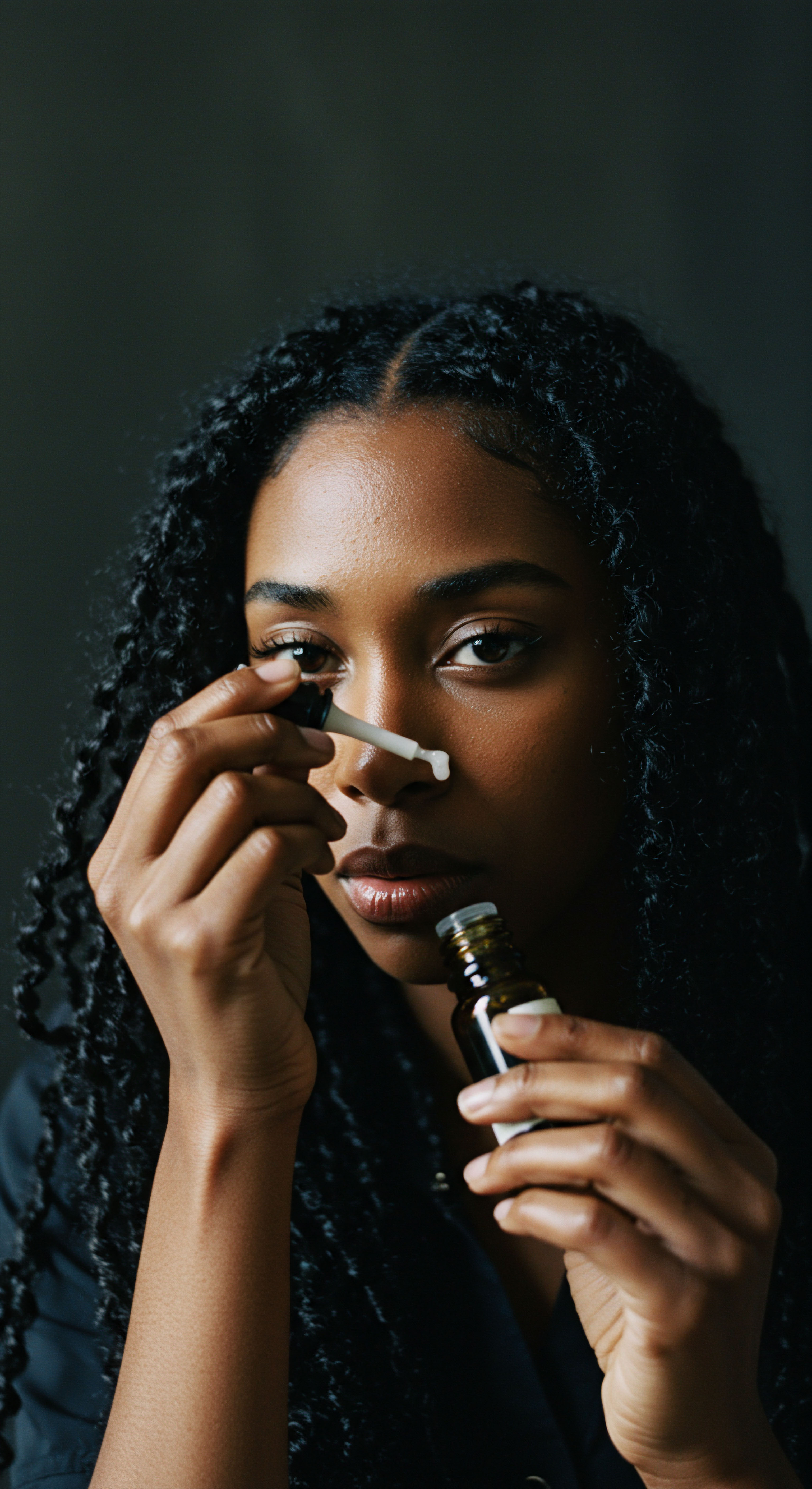
Roots
The quiet hours of night hold a particular significance for our hair, a time when strands might rest or endure. For those with textured hair, this nocturnal period presents a distinct set of considerations, a subtle dance between protection and vulnerability. We often seek solace in sleep, yet the surfaces upon which our heads repose can dictate the morning’s greeting from our tresses. It is a question whispered in many homes ❉ how does the material beneath our heads truly affect the delicate architecture of our hair as we slumber?
Understanding this begins with a simple truth ❉ hair, particularly that with curls, coils, and waves, possesses a unique structure. Its outer layer, the cuticle, resembles tiny shingles, overlapping to shield the inner cortex. When these shingles lie flat, hair appears smooth and reflects light beautifully.
When disturbed, they lift, leading to a less harmonious appearance. The interaction between hair and fabric during sleep is a constant negotiation with these delicate cuticles.
The nocturnal hours shape hair’s well-being, influencing its appearance and integrity upon waking.

The Architecture of Hair Strands
Each hair strand, though seemingly simple, comprises a complex layering. The medulla, a central core, is often absent in finer hair. Surrounding it is the cortex, providing strength and elasticity. The outermost shield, the cuticle, consists of flattened, dead cells, overlapping like roof tiles.
These cuticular scales are the primary point of contact with external elements, including our sleep surfaces. The condition of these scales directly influences how hair feels and looks. When cuticles are raised, moisture can escape more readily, and strands become more susceptible to external friction.
For textured hair, the helical nature of the strand means there are more points of potential contact and friction with surfaces. The bends and curves inherent in coily and curly patterns mean that these areas are more exposed to mechanical stress. This inherent geometry means that any material causing friction has a greater surface area to work upon, leading to increased potential for disruption along the strand’s length.

Fiber Composition and Hair Interaction
The very make-up of the fabric against which hair rests plays a central role. Consider the natural fibers of cotton and silk. Cotton, a plant fiber, consists primarily of cellulose.
Its individual fibers, when viewed under magnification, reveal a rough, somewhat irregular surface. This inherent characteristic means cotton threads possess microscopic hooks and loops, creating a texture that readily grips hair strands.
Silk, conversely, is an animal protein fiber, primarily composed of fibroin. Its structure is smooth and long, lacking the same microscopic irregularities found in cotton. The fibers of silk are naturally slick, allowing for a gentle glide rather than a snagging hold. This fundamental difference in fiber composition and surface topography sets the stage for their divergent interactions with hair during sleep.
| Property Fiber Source |
| Cotton Plant (Cellulose) |
| Silk Animal (Protein) |
| Property Surface Texture |
| Cotton Rough, Irregular |
| Silk Smooth, Uniform |
| Property Moisture Absorption |
| Cotton High (Hydrophilic) |
| Silk Moderate (Hydrophobic Tendency) |
| Property Friction Coefficient |
| Cotton Higher |
| Silk Lower |
| Property These properties shape their interaction with hair. |

The Question of Moisture Equilibrium
Hair’s vitality is deeply tied to its moisture content. Cotton, being a highly absorbent material, readily wicks away moisture. This property, while beneficial for towels, can be detrimental to hair, particularly for those with textured strands that are naturally prone to dryness. As the hours pass during sleep, a cotton pillowcase can act as a sponge, drawing hydration from hair, leaving it feeling parched and brittle.
Silk, on the other hand, possesses a different relationship with moisture. While it does absorb some moisture, its protein structure means it does not strip hair of its natural hydration in the same aggressive manner as cotton. It allows hair to retain its moisture, maintaining a more balanced internal environment throughout the night. This distinction is paramount for preserving the suppleness and elasticity of hair.
- Cotton’s absorbency can lead to dehydrated hair.
- Silk’s protein structure helps hair maintain its moisture.
- Balanced hydration supports cuticle integrity and hair health.

Ritual
As we turn our thoughts to the nightly ritual of rest, the choice of what cradles our hair becomes a conscious decision, one that speaks to our desire for preservation and gentle care. This is where the tangible differences between silk and cotton truly manifest, moving beyond their elemental composition into the realm of practical experience. The practices we adopt before sleep can either safeguard our hair’s condition or inadvertently contribute to its challenges.

Friction’s Silent Impact
The most immediate and discernible difference between cotton and silk lies in their frictional properties. Cotton’s coarse fibers create mechanical resistance as hair moves across its surface during sleep. This constant rubbing can cause the delicate cuticles to lift and even chip away, leading to what many describe as frizz and breakage. The microscopic snags on a cotton pillowcase can literally pull and stretch individual hair strands, weakening them over time.
Silk, with its exceptionally smooth surface, dramatically reduces this friction. Hair glides effortlessly across silk, minimizing the mechanical stress on the cuticle. This gentle interaction means less snagging, less pulling, and a significantly reduced likelihood of cuticle damage.
The result is hair that appears smoother, feels softer, and is less prone to tangling upon waking. This reduced friction is particularly beneficial for textured hair, which is inherently more fragile at its points of curl and coil.
Silk’s smooth surface lessens friction, protecting hair’s outer layer from damage during sleep.

Preserving Hair Styles Overnight
Beyond the microscopic integrity of the hair strand, the choice of sleep surface also influences the longevity of hairstyles. For those who invest time and effort into defining curls, twisting, or braiding their hair, maintaining these styles overnight is a constant concern. Cotton’s propensity to absorb moisture and create friction can quickly disrupt a carefully crafted style, leading to flattened curls, frizzy edges, and a general loss of definition. The moisture wicking also means that any styling products applied may be absorbed by the pillowcase rather than remaining on the hair.
Silk’s smoother surface and moisture-retaining qualities assist in preserving hairstyles. Curls maintain their shape, twists stay intact, and braids remain neat. The hair slides rather than rubs, preventing the disheveling that cotton often causes.
This aspect translates into less need for restyling in the morning, saving both time and further manipulation of delicate strands. It speaks to a gentler approach to hair care, where the night hours work with, rather than against, styling efforts.
- Minimize manipulation for longer-lasting styles.
- Choose sleep surfaces that respect hair’s delicate structure.
- Reduce morning styling time with protective nighttime practices.

Addressing Breakage and Split Ends
Hair breakage and split ends are common frustrations, particularly for those with textured hair. These issues are often exacerbated by mechanical stress. The constant rubbing against a rough surface, like a cotton pillowcase, can weaken the hair shaft, leading to breakage along the strand and the splitting of ends. Over time, this contributes to a perceived lack of growth and overall hair thinning.
Silk’s ability to reduce friction directly addresses these concerns. By allowing hair to glide freely, it significantly lessens the mechanical forces that contribute to breakage and split ends. This protective quality supports the hair’s structural integrity, allowing it to grow longer and appear fuller.
For those seeking to retain length and improve the overall appearance of their hair, this protective aspect of silk is a substantial consideration. It shifts the nightly experience from one of potential damage to one of gentle preservation.

Considerations for Different Hair Types
While the principles of friction and moisture apply universally, their impact can vary based on hair type. Finer hair, which is inherently more fragile, may experience accelerated damage from cotton’s rough surface. Denser, coarser textures might withstand more friction, but they are equally susceptible to moisture loss, which can lead to stiffness and reduced elasticity.
For highly porous hair, which readily absorbs and loses moisture, cotton’s absorbent nature can be particularly drying. Low porosity hair, which struggles to absorb moisture, may still benefit from silk’s non-absorbent properties by allowing any applied products to remain on the hair surface, rather than being wicked away. Ultimately, while all hair types can see improvements with silk, those with delicate, dry, or highly textured hair may experience the most pronounced positive changes.

Relay
Beyond the visible changes in hair texture and style, what deeper, often unseen, interactions occur between our hair and its nocturnal resting place? The scientific underpinning of material interaction with biological structures offers a profound understanding of why the seemingly simple choice between cotton and silk holds such weight. This is not merely about comfort; it concerns the very longevity and vitality of our hair at a cellular and mechanical level, a consideration often overlooked in daily discussions of hair care.

The Tribological Dance of Fibers
Hair’s nightly movement across a pillowcase initiates a tribological event, a study of friction, wear, and lubrication. The very act of turning on a cotton pillow can subject hair cuticles to micro-abrasions. Research in tribology, the science of interacting surfaces in relative motion, demonstrates that materials with higher coefficients of friction, such as cotton, can induce greater shear forces upon delicate hair strands compared to the smoother, tightly constructed fibers of silk. This mechanical stress, repeated hundreds of times each night, cumulatively contributes to the lifting and eventual fracturing of the cuticle layer.
Consider the microscopic reality ❉ a single hair strand, measuring mere micrometers in diameter, encounters countless cellulose fibers in cotton, each capable of snagging or resisting its movement. This consistent micro-trauma, though imperceptible in the moment, leads to a gradual degradation of the hair shaft’s outer shield. This process is not a sudden catastrophe but a slow erosion, manifesting as increased frizz, dullness, and a heightened susceptibility to further damage from styling or environmental factors. This persistent, low-level mechanical assault on the hair’s surface is a less commonly discussed yet scientifically documented reality of cotton’s interaction with hair.
Nightly hair movement against certain fabrics causes microscopic damage, a subtle yet cumulative process.

Does Fabric Choice Alter Scalp Micro-Environments?
The influence of sleep surfaces might extend beyond the hair shaft to the scalp itself. The scalp hosts a complex ecosystem of microorganisms, a delicate balance that contributes to overall hair health. Cotton’s high absorbency means it can readily soak up not only moisture from hair but also oils, sweat, and cellular debris from the scalp. This creates a potentially more humid and nutrient-rich environment directly against the scalp, which, under certain conditions, could influence the balance of the scalp microbiome.
While direct studies linking pillowcase material to scalp microbiome shifts are still developing, the principles of microbial ecology suggest that altered moisture and nutrient availability could favor the growth of certain microorganisms over others. A constantly damp or excessively oily scalp environment, exacerbated by an absorbent fabric, might contribute to conditions such as seborrheic dermatitis or other scalp irritations for sensitive individuals. Silk, being less absorbent and more breathable, may create a drier, more stable micro-environment, potentially reducing these risks by not creating a breeding ground for opportunistic microbes. This subtle interaction between fabric, moisture, and the scalp’s microbial inhabitants represents a deeper, more theoretical dimension of nighttime hair care.

The Thermal Regulation of Fibers
Another often-overlooked aspect is the thermal regulation provided by different fabrics. Sleep quality itself is influenced by temperature, and the microclimate around our head plays a part. Cotton, while breathable, can sometimes retain heat and moisture close to the scalp due to its absorbency. This can lead to increased perspiration, which then contributes to the very moisture-wicking cycle that dries out hair.
Silk, with its natural protein structure, possesses excellent thermal regulating properties. It helps to keep the head cool in warmer conditions and provides a degree of warmth in cooler ones. This breathability and temperature neutrality can contribute to a more stable environment for both the hair and scalp, minimizing excessive sweating and the subsequent drying effect that evaporation can have on hair. This nuanced interaction with body temperature adds another layer to silk’s protective qualities for hair.
| Factor Friction on Cuticle |
| Cotton Pillowcase Influence High (Micro-abrasions) |
| Silk Pillowcase Influence Low (Smooth Glide) |
| Factor Moisture Absorption from Hair |
| Cotton Pillowcase Influence High (Dehydration) |
| Silk Pillowcase Influence Low (Moisture Retention) |
| Factor Scalp Microclimate Humidity |
| Cotton Pillowcase Influence Potentially Higher |
| Silk Pillowcase Influence Potentially Lower/More Stable |
| Factor Thermal Regulation |
| Cotton Pillowcase Influence Can Trap Heat/Moisture |
| Silk Pillowcase Influence Breathable, Temperature Neutral |
| Factor Fabric choice affects both hair and scalp health. |

Cultural Significance of Hair Coverings at Night?
Across various cultures, the practice of covering hair at night holds historical and symbolic significance, often predating modern scientific understanding of hair care. From intricately tied head wraps to simple scarves, these traditions speak to a long-held awareness of hair’s vulnerability during sleep. While the materials used historically varied widely, the underlying intention was often one of protection, cleanliness, and modesty.
The modern adoption of silk bonnets and pillowcases for textured hair can be seen as a contemporary extension of these ancient practices, now bolstered by scientific understanding. These traditions, though rooted in diverse beliefs and customs, intuitively grasped the necessity of shielding hair from external elements during rest. The current scientific data on friction and moisture simply provides a detailed explanation for practices that were once passed down through generations, underscoring a timeless wisdom regarding hair’s delicate nature. This convergence of ancestral knowledge and contemporary research highlights a continuous human endeavor to care for and honor hair.
- Ancient practices of hair covering speak to timeless wisdom.
- Modern science explains the protective aspects of these traditions.
- Cultural continuity connects past and present hair care rituals.

Reflection
The quiet moments of night, when the world outside softens and we retreat into our personal sanctuaries, hold an understated yet profound influence on the well-being of our hair. The choice of what cradles our strands as we dream is more than a mere aesthetic preference; it is a gentle affirmation of care, a silent promise to preserve the natural vitality and unique character of our textured hair. To understand the subtle yet powerful distinctions between silk and cotton for this nightly repose is to step into a deeper relationship with our hair, honoring its delicate needs and celebrating its inherent strength. It is a quiet wisdom, guiding us towards a future where every strand feels cherished, every curl retains its definition, and every morning begins with a serene sense of hair’s enduring beauty.

References
- Robbins, C. R. Chemical and Physical Behavior of Human Hair. Springer, 2012.
- De Gannes, S. A. J. L. “The Influence of Fabric Surface Properties on Hair Frizz.” Journal of Cosmetic Science, vol. 68, no. 6, 2017, pp. 455-464.
- Lim, D. P. K. Lee, S. R. and Kim, J. K. “Comparative Study on the Physical Properties of Silk and Cotton Fabrics for Sleepwear.” Fibers and Polymers, vol. 19, no. 11, 2018, pp. 2422-2429.
- McMichael, A. J. and Khumalo, N. P. Hair and Scalp Diseases ❉ Medical, Surgical, and Cosmetic Treatments. CRC Press, 2017.
- Wagner, R. and Khumalo, N. P. “Hair Care Practices in Individuals of African Descent ❉ A Review.” International Journal of Dermatology, vol. 54, no. 11, 2015, pp. 1211-1219.
- Krasnoff, S. B. The Science of Silk. Chelsea House Publishers, 2005.
- Lewin, M. Handbook of Fiber Chemistry. CRC Press, 2007.